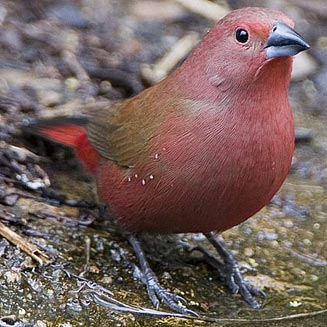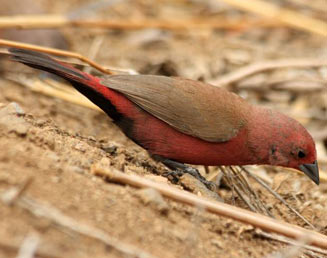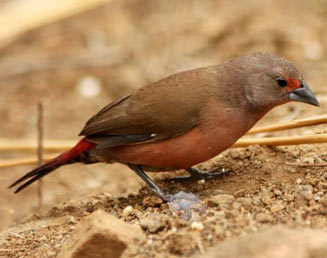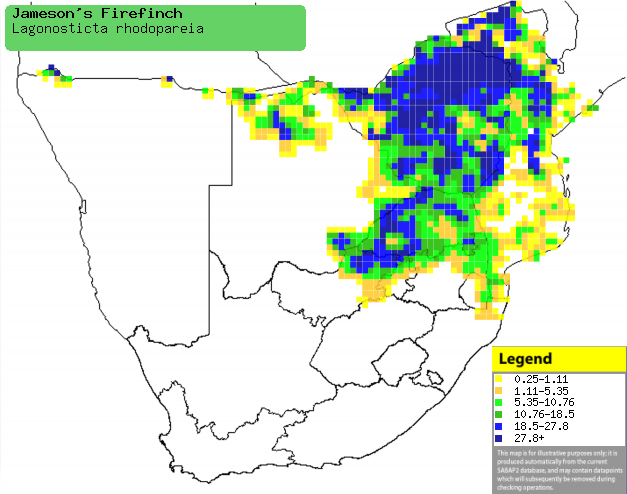|
Lagonosticta rhodopareia
(Jameson's firefinch)
Jamesonse vuurvinkie [Afrikaans]; Xidzingirhi (generic term
for firefinches and waxbills; also applied to Ground woodpecker [check])
[Tsonga]; Roze amarant [Dutch]; Amarante de Jameson [French];
Rosenamarant, Jamesons amarant [German]; Peito-de-fogo de Jameson
[Portuguese]
Life
> Eukaryotes >
Opisthokonta
> Metazoa (animals) >
Bilateria >
Deuterostomia > Chordata >
Craniata > Vertebrata (vertebrates) > Gnathostomata (jawed
vertebrates) > Teleostomi (teleost fish) > Osteichthyes (bony fish) > Class:
Sarcopterygii (lobe-finned
fish) > Stegocephalia (terrestrial
vertebrates) > Tetrapoda
(four-legged vertebrates) > Reptiliomorpha > Amniota >
Reptilia (reptiles) >
Romeriida > Diapsida > Archosauromorpha > Archosauria >
Dinosauria
(dinosaurs) > Saurischia > Theropoda (bipedal predatory dinosaurs) >
Coelurosauria > Maniraptora >Aves
(birds) > Order: Passeriformes
> Family: Estrildidae
 |
 |
|
Jameson's firefinch male. [photo
Callie de Wet ©] |
Jameson's firefinch male, Nylsvlei, South Africa. [photo Trevor Hardaker ©] |
 |
 |
|
Jameson's firefinch male (left) and female
(right), Kruger National Park, South Africa. [photo Alan Manson
©] |
Distribution and habitat
Occurs in patches from Ethiopia through Kenya and Tanzania
to Malawi, Zambia, Angola and southern Africa. Here it is locally common from
Zimbabwe and Mozambique to north-eastern South Africa, northern and eastern
Botswana and northern Namibia (including the Caprivi Strip). It generally prefer
rank grass in wooded habitats, especially along watercourses in more arid areas,
also occupying edges of riverine forest and cultivated land.
|
 |
|
Distribution of Jameson's firefinch in southern
Africa, based on statistical smoothing of the records from first SA Bird
Atlas Project (©
Animal Demography unit, University of
Cape Town; smoothing by Birgit Erni and Francesca Little). Colours range
from dark blue (most common) through to yellow (least common).
See here for the latest distribution
from the SABAP2. |
Predators and parasites
It has been recorded as prey of
Accipiter minullus (Little
sparrowhawk)
Food
It mainly eats fallen grass seeds, supplemented with
insects taken from the ground or hawked aerially. The following food items have been recorded
in its diet:
- Grass seeds
- Echinochloa colona (Jungle rice)
- Setaria (bristle grasses)
- Urochloa (signal grasses)
- Panicum (guinea grasses)
- Eragrostis tef (Teff grass, eaten in captivity)
- Insects
Breeding
- The nest is usually built by both sexes, consisting of an oval-shaped
structure with a side entrance, made of dry grass with an inner shell of soft grass
inflorescences, lined with feathers. It is typically placed near the ground in a
grass tuft, among dead plant material or at the base of a tree or bush.
- Egg-laying season is year-round peaking in Summer, from December-April.
- It lays 2-7 eggs, which are incubated by both sexes for about 12-15
days.
- The chicks are brooded and fed by both parents, leaving the nest after
about 16-19 days, becoming fully independent approximately two weeks later.
Threats
Not threatened.
References
-
Hockey PAR, Dean WRJ and Ryan PG 2005. Roberts
- Birds of southern Africa, VIIth ed. The Trustees of the John Voelcker
Bird Book Fund, Cape Town.
|
